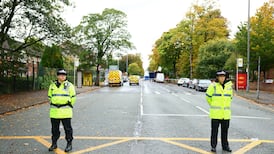Kate Forbes has pulled out of the race to be the leader of the Scottish National Party and Scotland’s new first minister, and has instead rowed in behind the front runner John Swinney.
He has indicated he will bring Ms Forbes, who was finance secretary under former leader Nicola Sturgeon, back into the heart of Scotland’s devolved government, potentially uniting the SNP as it prepares for an election showdown with a resurgent Labour Party.
One member of the Scottish parliament told The Irish Times on Thursday it was the coming together of the party’s “dream team”.
It appears a deal was struck following discreet talks on Wednesday between the two, who were the only plausible contenders to replace outgoing first minister Humza Yousaf, who quit on Monday after botching the ending of the SNP’s government partnership with the Scottish Greens.
After a behind-the-scenes standoff for several days between supporters of Ms Forbes and Mr Swinney, signals emerged on Thursday that an agreement had been reached.
First Mr Swinney, a party veteran who was Ms Sturgeon’s deputy first minister, called journalists and party members to a meeting at 10.30am in Edinburgh’s Old Town, where he announced his candidacy and promised to heal the party. He said he wanted Ms Forbes to play a significant role and praised her abilities and energy.
“Who is going to put the SNP back together again?” he said, referring to how the party has been roiled by a financial scandal and also by internal division over its political identity and the apparent stalling of its bid for independence.
Mr Swinney said opinion polls showed that he and Ms Forbes were both “miles ahead” of the leaders of Scottish Labour and the Scottish Conservatives as potential first ministers in the eyes of voters: “That shows me the SNP has the people who are in touch with the public.”
He promised to “draw the SNP together in one united team”.
Ms Forbes, who was narrowly beaten by Mr Yousaf in a bitter and divisive leadership contest last year after Ms Sturgeon stepped down, is by far the most popular SNP politician in Scotland with voters outside of the party. A social and religious conservative who has faced relentless scrutiny for her views on issues around marriage and sex, the 34-year-old is less popular with her party’s MSPs – members of parliament – than Mr Swinney. But she is seen as a talented politician and is respected by Scotland’s business community.
Three hours after Mr Swinney’s announcement, Ms Forbes released a statement saying she had listened “very carefully” to his campaign launch. She cited his apparent “commitment to ensure internal respect for robust and divergent debate in the party”, a seemingly coded promise to continue to stake out her own views.
She said she believed Mr Swinney agreed with her that the economy and fighting poverty needed to take precedence over climate issues, where they clashed. She said she would not seek to be the “next SNP leader”, leaving open the possibility she might try again in future, and backed Mr Swinney.
For his part, Mr Swinney insisted he was not a “caretaker leader” on an interim mission, and promised, if installed in the top job, to lead the SNP and Scotland beyond the next elections for the devolved Holyrood parliament in 2026. The SNP will also run in the Westminster elections later this year, when Labour will aim to take up to half of its seats.
Nominations for the SNP leadership close on Monday. If, as expected, no other candidate emerges, Mr Swinney will be crowned SNP leader next week. He will then need to reach out to other parties to win the backing of parliament to become first minister of a minority SNP administration.








